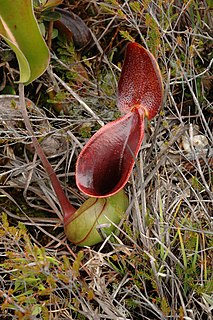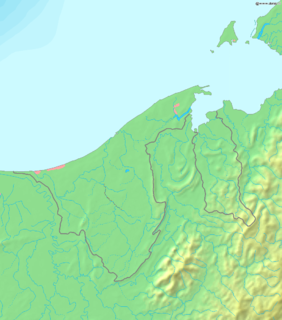
Brunei is a country in Southeast Asia, bordering the South China Sea and East Malaysia. Its geographical coordinates are 4°30′N114°40′E.

Limbang is a border town and the capital of Limbang District in the Limbang Division of northern Sarawak, East Malaysia, on the island of Borneo. It is located on the banks of the Limbang River, between the two halves of Brunei.
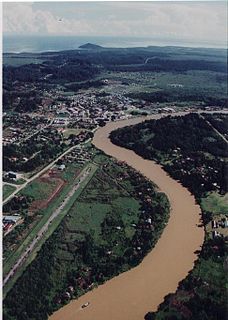
Lawas is a small town and the capital of Lawas District, Limbang Division, Sarawak, Malaysia. This district area is 3,811.9 square kilometres, and population was 35,300. It is 1200 km from the state capital, Kuching and 200 km from the capital city of Sabah, Kota Kinabalu.
Dr. Charles M. Clarke is an ecologist and botanist specialising in the carnivorous plant genus Nepenthes, for which he is regarded as a World Authority. Clarke has an honours degree in Botany from Monash University in Melbourne, and a Ph.D. in Ecosystem management at the University of New England, in Armidale, New South Wales.

Nepenthes ephippiata, or the saddle-leaved pitcher-plant, is a tropical pitcher plant endemic to Borneo. It occurs in the Hose Mountains of central Sarawak, as well as Mount Raya and Bukit Lesung in Kalimantan. Non-climbing plants from the Hose Mountains appear to have less decurrent leaf attachment than specimens from Central Kalimantan, however the characteristic saddle after which the species is named is fully developed in climbing plants. Nepenthes ephippiata is closely related to N. lowii.
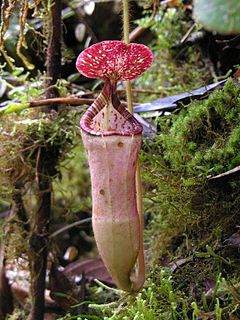
Nepenthes pilosa is a tropical pitcher plant endemic to Borneo. It is characterised by a dense indumentum of long yellow-brown hairs. Pitchers have a distinctive hook-shaped appendage on the underside of the lid. The specific epithet derives from the Latin word pilosus, meaning "hairy".
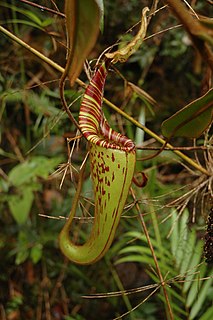
Nepenthes hurrelliana is a tropical pitcher plant endemic to Borneo, where it has been recorded from northern Sarawak, southwestern Sabah, and Brunei. It is of putative hybrid origin; its two original parent species are thought to be N. fusca and N. veitchii. A thick indumentum of rusty-brown hairs covers the entire plant, a characteristic presumably inherited from the latter.
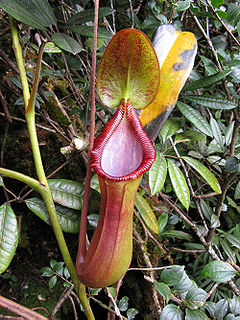
Nepenthes × trusmadiensis, or the Trus Madi Pitcher-Plant, is a natural hybrid of two famous Bornean pitcher plant species: N. lowii and N. macrophylla. It is restricted to Mount Trus Madi, where both of its parent species are sympatric.
Bukit Batu Buli is a mountain located in the Malaysian part of Borneo. At 2,082 metres, it is one of the highest mountains in the state of Sarawak.
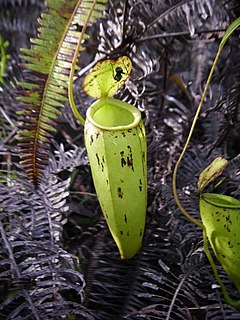
Nepenthes × trichocarpa, the Dainty Pitcher-Plant, is a common natural hybrid involving N. ampullaria and N. gracilis. It was originally thought to be a distinct species and was described as such.

Nepenthes × kuchingensis is a natural hybrid between N. ampullaria and N. mirabilis. Although it is named after the city of Kuching in Sarawak, this plant has a wide distribution across Borneo, New Guinea, Peninsular Malaysia, Sumatra, and Thailand.

Nepenthes chaniana is a tropical pitcher plant species belonging to the genus Nepenthes. It is characterised by a dense indumentum of long, white hairs. Pitchers are cylindrical and mostly white to yellow in colouration. Nepenthes chaniana belongs to the loosely defined "N. maxima complex", which also includes, among other species, N. boschiana, N. epiphytica, N. eymae, N. faizaliana, N. fusca, N. klossii, N. maxima, N. platychila, N. stenophylla, and N. vogelii.
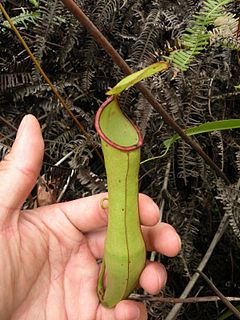
Nepenthes × sharifah-hapsahii is a natural hybrid between N. gracilis and N. mirabilis. It has been recorded from Borneo, Peninsular Malaysia, Sumatra, and Thailand, although it was originally described as a species endemic to Peninsular Malaysia, where it was said to grow at elevations below 1000 m.

The Lun Bawang is an ethnic group found in Central Northern Borneo. They are indigenous to the highlands of North Kalimantan, Brunei, southwest of Sabah and northern region of Sarawak. In the Malaysian state of Sarawak, the Lun Bawang are officially recognised by the Constitution as native of Sarawak and are categorised under the Orang Ulu people; whilst in the neighbouring state of Sabah and Krayan highland in Kalimantan, they are sometimes named Lundayeh or Lun Daye. In Brunei, they are also identified by law as one of the 7 natives of Brunei, through the term Murut. Nevertheless, in Sabah, Kalimantan and Brunei, the term Lun Bawang is gaining popularity as a unifying term for this ethnic across all region. There are also other alternative names such as Lun Lod, Lun Baa' and Lun Tana Luun.

The Lambir Hills National Park is a national park in Miri Division, Sarawak, Malaysia, on the island of Borneo. It is a small park, at 6,952 hectares, and is composed largely of mixed dipterocarp forest, with some small areas of 'kerangas'. The park is 150–465 m (492–1,526 ft) above sea level.

The following outline is provided as an overview of and a topical guide to Brunei:

The Heart of Borneo is a conservation agreement initiated by the World Wide Fund for Nature to protect a 220,000 km² forested region on Borneo island that is known as Asia's last great rainforest. The agreement has been signed by the governments of Brunei, Indonesia and Malaysia in Bali on 12 February 2007 to support the initiative. The region provides habitat to 10 endemic species of primate, more than 350 birds, 150 reptiles and amphibians and 10,000 plants. From 2007 to 2010 a total of 123 new species have been recorded in the region. A status report from 2012 found that the lowland rain forest within the area is deteriorating and under threat. The Bornean rhinoceros was the most threatened fauna, with an estimated 25 individuals remaining. As of 2015, they are extinct in the wild with only 3 individuals remaining in captivity in Sabah.
The Institute for Biodiversity and Environmental Research in Brunei Darussalam is a research institute of Universiti Brunei Darussalam (UBD) dedicated to biodiversity and environmental sciences research and education. IBER’s location within the northwest Borneo hotspot offers unique opportunities for long-term studies in both terrestrial and marine tropical ecosystems.




